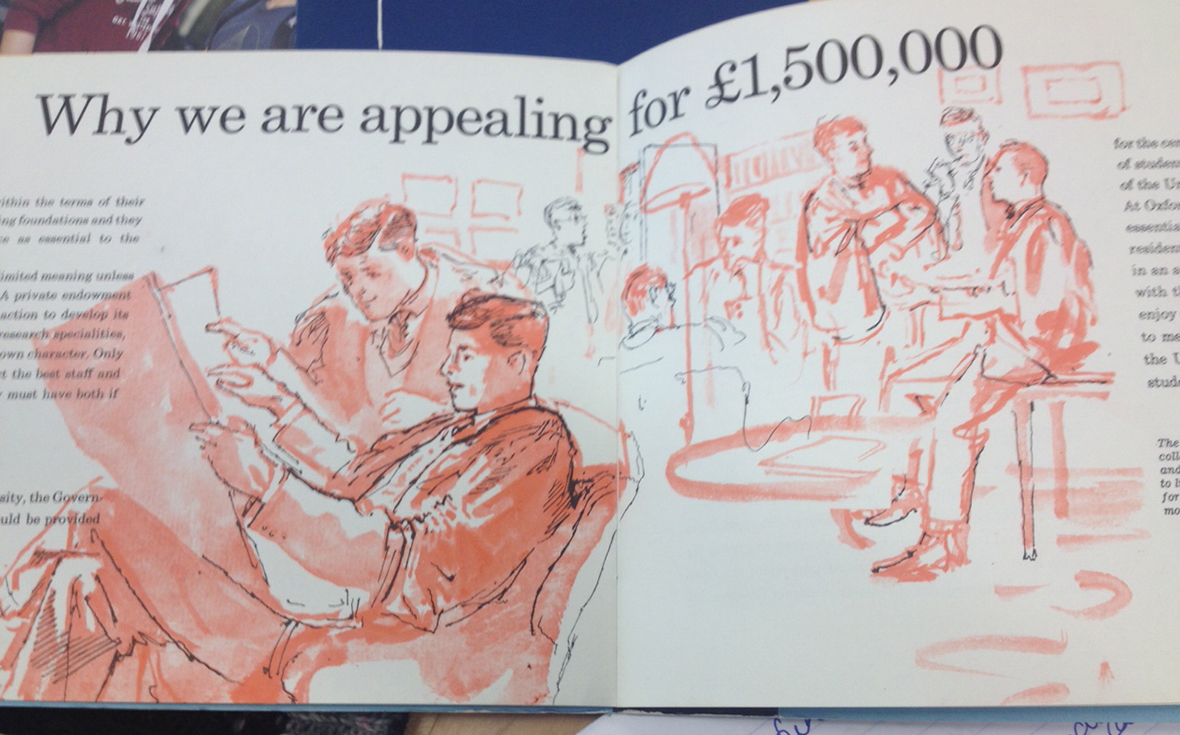
Opinion
Five surprises from the archives (with lessons for today)
by Elin Williams - 25 October 2016

Opinion
Five surprises from the archives (with lessons for today)
by Elin Williams - 25 October 2016
Elin Williams, More Partnership’s copywriter, reflects on what the past can teach us about UK higher-education fundraising…
This summer, I was lucky enough to spend a few hours immersed in concrete. More precisely, I went on a day trip to the University of East Anglia’s underground archive. What I discovered there, deep beneath the famous “brutalist” landscape of ziggurats and walkways, reminded me of a similar light-bulb moment at the University of Essex (on another More Partnership mission) a few years ago. This time around, I thought I’d share my findings.
1. Fundraising for UK higher education never went away.
It’s tempting to see benefaction as something set in Oxbridge stone or philanthropy as something the Victorians did. The nineteen-sixties, so we assume, were all about full grants and government-funded university expansion, not to mention miniskirts, mini cars and yeah-baby. But in fact, educational fundraising was big in sixties Britain. And the decade’s new universities were built on donations, not just progressive political policy.
The language was different back then, of course. There was an “appeal” to build UEA, not a “campaign”. And “private benefaction” or “support from private citizens”, not “individual giving”, was the objective. But the fundamentals were the same. There was a committee of VIPs, a brochure (though not a “case for support”) and no launch until pledges of £650,000 had been reached towards the £1.5 million target.
The moral is that we Brits should stop thinking about fundraising as a recent American import and start reclaiming it as our own proud – and surprisingly unbroken – tradition. Of course, we’re British, so we’ll always apologise. But we don’t need to apologise for being fundraisers. Nor do we have to use euphemisms like “development” and “advancement”. As well as dispelling confusion, this will make it much easier to explain our jobs to our friends.
2. Philanthropy may have helped to win the Cold War.
In his initial fundraising document, UEA’s founding Vice-Chancellor wrote: “Why should donations be sought? In a completely planned society this question would not arise. Fortunately, we live in a mixed society, which rests upon the interplay of a public and private sector.” It seems a bit of an odd thing to say in the context of an appeal… until you remember the Cold War, which was even bigger in the sixties than the Beatles.
Today, the scales have tipped. The Cold War is won. The political hot potatoes are now: rising fees; falling social mobility; and the impact of Brexit. What hasn’t changed is that fundraisers are ever entangled in politics.
But let’s take our cue from Professor Thistlethwaite, who was raising funds for higher education before Britain had even joined the “Common Market”. Like him, we should look on the bright side. In the UK, we’re still fortunate to live in a mixed society and, unlike the Ivy League over the pond or most of the Grandes Écoles across the Channel, our universities get significant government support… which makes our job as fundraisers easier than it might otherwise be. Hurrah!
3. The sixties universities held their own with Oxbridge for a while.
“In those days there was a sense that something new could be done… an emergence into sunny uplands, to new, extended horizons,” reminisced Frank Thistlethwaite in a speech many years after UEA had been founded.
It seems that the so-called “Shakespearean Seven” universities (Essex, Kent, Lancaster, Sussex, Warwick, York… and Norfolk aka East Anglia) really did capture applicants’ imaginations. The brave new campuses seemed much more exciting than the staid old alternatives. “For several undergraduate generations,” confirms Frank Thistlethwaite, “we held our own with Oxford and Cambridge in the competition for talent.” And my father-in-law, who left Warwick in the early seventies with a first and some very wide trousers, has always made the same claim.
We can debate whether or not such assertions are true, but there’s no doubt that some pretty brilliant young minds were attracted to UEA and its contemporaries in the early years. And guess what? Most of these pioneers are between sixty and seventy today… which is precisely the age bracket when people tend to give most to their alma maters. This is good news if you’re a fundraiser whose office looks out onto a landscape of plate glass and concrete. Hurrah again!
4. We’re not as clever as we think we are at communications.
The first case for support I worked on professionally won a CASE Grand Gold Medal, which has always made me feel quite smug. So I was shocked to discover its long-lost twin in the UEA archive. When I think of what we paid those trendy London designers for the retro styling and uncoated paper!
But it wasn’t just the design that looked familiar. One of the subheads (“How to contribute”) was used in my award-winning brochure. And the “shop window” approach that we advocate at More Partnership was already in full swing (“The following are only illustrations of a wide range of needs…”).
It’s tempting to conclude: what goes around comes around. But the lesson is really that a good message and good design are timeless.
Indeed, some of the messages from the sixties are arguably clearer than today’s. When we analysed the collected feedback from some recent More Partnership feasibility studies, a recurring complaint was that cases for support rarely come clean about what will happen if the target isn’t met. But the UEA brochure is unflinching: no private funding means no student accommodation, which means a university with no soul.
The only consolation is that we do imagery much better these days. The artist’s impression of UEA’s tweedy, pipe-smoking young fogeys is vindication that twenty-first century political correctness hasn’t gone mad. Here it is so that you can have a good giggle. But don’t stay smug for too long.

5. History matters, after all.
As a professional copywriter, I learned my trade in the “benefits, not features” school of communications. Here, there’s automatic expulsion for anyone who begins a web page or a brochure with the words “Founded in x…” (where x is a year). I sometimes think that I chose this line of work because I hated history so much at school.
But I was wrong to hate history. And higher education fundraising isn’t the same as marketing or student recruitment. This lesson was driven home to me recently when I found myself talking to an 87-year-old alumnus of another More Partnership client. It soon became clear from our comic cross-purposes that the institution I was writing about had changed beyond all recognition from the institution he’d attended in 1960. If I’d been a fundraiser looking for money, not a copywriter looking for a story, I’d have deserved the sack.
In other words, when we’re talking to alumni, history really does matter. It’s worth taking the time to go down the archives and dig out old recruitment brochures, graduation photos and even fundraising materials. If we can’t be bothered to find out about their past, why should they be bothered to give to our future?
UEA Campaign Update
The University of East Anglia recently extended the Difference campaign, doubling their initial target of £50m and raising their sights further still. Find out more in their new video: